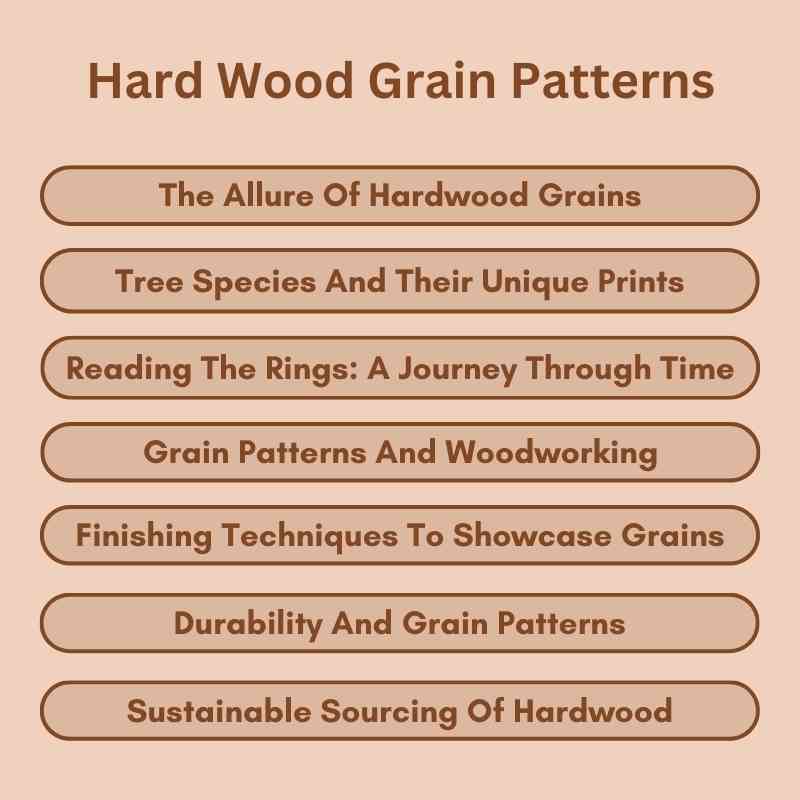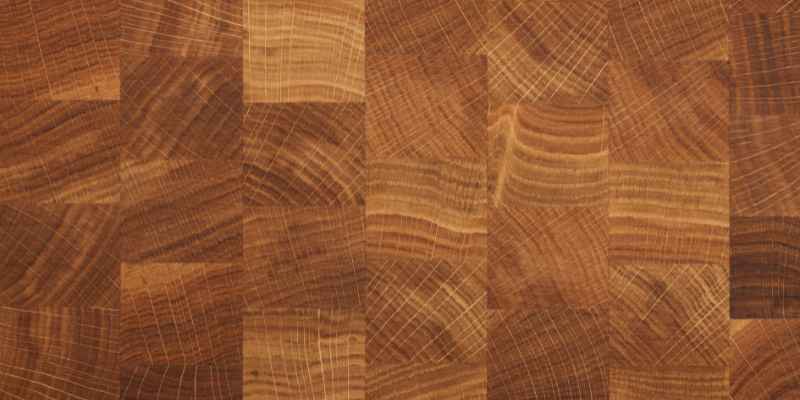Hardwood grain patterns refer to the distinct visual textures found in hardwood species. These patterns vary significantly, influenced by the type of wood and its growth conditions.
Understanding hardwood grain patterns is essential for anyone interested in woodworking, furniture design, or home decor. Each type of hardwood showcases unique characteristics, ranging from straight lines to intricate swirls. Popular hardwoods like oak, maple, and walnut present diverse grain patterns that can enhance the aesthetic appeal of any project.
Recognizing these patterns helps artisans choose the right wood for their needs, ensuring a visually pleasing result. Additionally, knowing how to identify and appreciate these grains can elevate your design skills and deepen your appreciation for natural materials. Explore the beauty of hardwood grain patterns for your next creative endeavor.
The Allure Of Hardwood Grains
Hardwood grains capture the beauty of nature. Each piece tells a unique story. Their patterns reveal the tree’s growth, age, and environment. These features make hardwoods a popular choice for many.
Capturing Nature’s Masterpiece
Hardwood grains are nature’s artwork. Every tree has its own grain pattern. Some woods have straight lines, while others show swirls and waves. This diversity gives hardwood its charm.
- Oak: Features prominent rays and flecks.
- Maple: Known for its smooth, fine grain.
- Walnut: Offers rich colors and intricate patterns.
- Cherry: Displays a warm, reddish hue that deepens over time.
These variations make hardwoods ideal for furniture and flooring. Each piece becomes a conversation starter. The natural patterns enhance any room’s aesthetic.
The Aesthetic Appeal Of Grain Patterns
Grain patterns add depth and character. They create visual interest in any design. Here are some benefits of these stunning patterns:
- Unique Look: No two pieces are identical.
- Timeless Elegance: Hardwood never goes out of style.
- Versatile Design: Fits many interior styles.
- Durability: Stands the test of time.
Homeowners value the beauty of hardwood. Its rich textures and tones bring warmth. Whether used in flooring, cabinets, or furniture, hardwood grains shine.
| Wood Type | Grain Characteristics | Color |
|---|---|---|
| Oak | Prominent rays, flecks | Light to medium brown |
| Maple | Smooth, fine grain | Light cream to light brown |
| Walnut | Intricate patterns | Dark brown to purplish |
| Cherry | Warm, even grain | Reddish-brown |
Hardwood grains are more than just wood. They are art pieces that connect us to nature. The allure of hardwood lies in its unique stories and beauty.

Tree Species And Their Unique Prints
Each tree species boasts unique wood grain patterns. These patterns reflect the tree’s life and environment. Understanding these differences enriches our appreciation for hardwoods.
Oak Majesty
Oak is renowned for its strength and durability. Its grain features a bold, prominent pattern. Oak grains can be straight or have a slight wave.
- Types of Oak:
- Red Oak
- White Oak
- Common Uses:
- Furniture
- Flooring
- Cabinetry
The color can range from light tan to deep brown. Oak’s unique rays add stunning visual interest.
The Swirls Of Walnut
Walnut wood is famous for its rich, dark hues. Its grain features beautiful swirls and waves. This gives it a luxurious appearance.
| Walnut Characteristics | Description |
|---|---|
| Color | Dark brown to purple-black |
| Grain Pattern | Straight, wavy, or irregular |
| Common Uses | High-end furniture, cabinetry, and musical instruments |
Walnut’s beauty and versatility make it highly sought after. It complements modern and traditional styles alike.
Maple’s Subtle Elegance
Maple wood is known for its light, creamy color. Its grain is often fine and straight. This gives it a clean and elegant look.
- Types of Maple:
- Sugar Maple
- Red Maple
- Common Uses:
- Cabinets
- Flooring
- Bowls
Maple can display beautiful flame or curly patterns. This adds depth and character to any project.
Reading The Rings: A Journey Through Time
Hardwood grain patterns tell stories of growth and survival. Each ring represents a year of life. Exploring these rings reveals secrets of the past. Nature leaves clues in every tree’s cross-section.
Decoding Age And History
Tree rings offer a glimpse into a tree’s age. Each ring marks a year of growth.
- Wide rings indicate favorable growing conditions.
- Narrow rings show stress from drought or disease.
Counting rings helps determine a tree’s lifespan. This method is called dendrochronology. It can also reveal historical events.
| Growth Ring Characteristics | Meaning |
|---|---|
| Thick rings | Healthy growth year |
| Thin rings | Stressful growth year |
| Dark rings | Unfavorable conditions |
| Light rings | Optimal growth |
Climate Tales Etched In Wood
Each ring reflects the climate during that year. Trees respond to environmental changes. Scientists study these changes through tree rings.
- Cold years produce tighter rings.
- Warm years lead to wider rings.
By examining rings, researchers learn about past climates. This study helps us understand climate change. The rings act like a historical record.
They show:
- Patterns of rainfall
- Temperature variations
- Natural disasters
Understanding these patterns helps us protect forests. It also guides future conservation efforts.
Grain Patterns And Woodworking
Grain patterns are the unique designs found in wood. These patterns vary greatly between different wood species. Understanding these patterns is essential for woodworking projects. They can enhance the beauty and character of your work. Choosing the right grain can make a project stand out.
Selecting The Right Grain For Projects
Choosing the right grain is crucial for any woodworking project. Different grains serve different purposes and aesthetics. Here are some key points to consider:
- Hardwoods: These often have intricate patterns. They add elegance to furniture.
- Softwoods: These usually have simpler grains. They are great for structural projects.
- Uniform Grain: Ideal for sleek, modern designs.
- Variegated Grain: Perfect for rustic or traditional projects.
Consider the following factors:
- Project Type: Choose grain based on the project’s needs.
- Finish: Some grains look better with certain finishes.
- Durability: Harder woods often have more durable grains.
Techniques To Enhance Natural Patterns
Enhancing natural grain patterns can elevate your woodworking projects. Here are effective techniques to consider:
- Staining: This can deepen colors and highlight patterns.
- Burnishing: Use a cloth to smooth the surface. This enhances shine.
- Oil Finishes: These can bring out the grain’s texture.
- Sandblasting: This method reveals hidden patterns in the wood.
Experiment with these techniques:
| Technique | Effect |
|---|---|
| Staining | Enhances color and depth |
| Burnishing | Increases shine and smoothness |
| Oil Finishes | Highlights grain texture |
| Sandblasting | Reveals hidden patterns |
Use these techniques wisely. They can transform ordinary wood into stunning pieces. Every grain has potential waiting to be discovered.
Finishing Techniques To Showcase Grains
Finishing techniques play a vital role in enhancing the beauty of hardwood grain patterns. The right approach can highlight natural textures and colors. This section explores effective methods to showcase those stunning grains.
Choosing The Perfect Stain
Selecting the right stain is crucial. It enhances the grain and enriches the wood’s appearance. Here are some tips for choosing the perfect stain:
- Understand wood type: Different woods absorb stains differently.
- Test samples: Always test stains on scrap pieces first.
- Consider color: Choose a color that complements your décor.
Stains come in many shades. Popular options include:
| Stain Color | Wood Type |
|---|---|
| Dark Walnut | Oak |
| Cherry | Maple |
| Natural | Birch |
The Role Of Sealants And Varnishes
Sealants and varnishes protect wood while enhancing grain. They provide a durable finish. Here’s why they matter:
- Protection: Sealants guard against moisture and damage.
- Enhancement: Varnishes can deepen color and shine.
- Longevity: A good finish extends the life of wood.
Different types of sealants include:
- Polyurethane
- Lacquer
- Shellac
Each type offers unique benefits. Choose one that fits your project needs.
Durability And Grain Patterns
Hardwood is known for its strength and beauty. The grain patterns add character and uniqueness. Understanding durability and grain patterns helps in choosing the right wood for your needs.
Strength In The Lines
The grain patterns in hardwood reveal its strength. Different species offer various characteristics. Here are some common types of hardwood grain patterns:
- Straight Grain: Consistent and uniform.
- Curly Grain: Wavy and visually striking.
- Quarter Sawn: Produces a unique ray flake pattern.
- Plain Sawn: Features a traditional look with varied patterns.
Each pattern affects the wood’s strength. For example, straight grain offers excellent stability. Curly grain may be more decorative but less stable.
Longevity And Care For Hardwood
Hardwoods are known for their longevity. Proper care extends their life even further. Follow these tips for maintaining hardwood:
- Clean regularly with a damp cloth.
- Avoid harsh chemicals and cleaners.
- Use coasters to prevent scratches.
- Apply wood polish every few months.
Remember, each type of hardwood has specific care needs. Here’s a quick comparison:
| Wood Type | Durability Rating | Care Tips |
|---|---|---|
| Oak | High | Polish regularly |
| Maple | Medium | Clean with mild soap |
| Cherry | Medium | Avoid direct sunlight |
Understanding grain patterns and durability makes choosing hardwood easier. Enjoy the beauty and strength of hardwood in your home.
Sustainable Sourcing Of Hardwood
Sustainable sourcing of hardwood is essential for our planet. It ensures forests remain healthy and productive. Responsible choices help protect ecosystems and support local communities.
The Impact Of Logging
Logging can have serious effects on the environment. Here are some key impacts:
- Deforestation: Trees are cut down faster than they can grow.
- Habitat Loss: Wildlife loses its natural home.
- Soil Erosion: Without trees, soil can wash away.
- Climate Change: Fewer trees mean more carbon in the air.
Unsustainable logging practices harm our planet. Choosing sustainable hardwood helps protect forests. It ensures that logging is done responsibly. This practice fosters regeneration and preserves biodiversity.
Certified Wood And Responsible Choices
Buying certified wood is a smart decision. Certifications indicate responsible sourcing practices. Here are popular certification programs:
| Certification | Organization |
|---|---|
| FSC | Forest Stewardship Council |
| PEFC | Programme for the Endorsement of Forest Certification |
These organizations ensure wood comes from well-managed forests. By choosing certified wood, consumers support sustainable forestry. This choice helps maintain the balance of nature.
Responsible choices also include:
- Researching suppliers.
- Avoiding illegal wood products.
- Opting for reclaimed wood.
- Supporting local artisans.
Each decision contributes to a healthier planet. Sustainable hardwood sourcing leads to a brighter future.
The Future Of Hardwood Design
The future of hardwood design is bright and exciting. Innovations are reshaping how we view and use hardwood. New trends in grain patterns add unique beauty to each piece. Designers and craftsmen are pushing boundaries to create stunning pieces.
Innovations In Woodworking
Woodworking is evolving with new technologies. Here are some key innovations:
- Laser Cutting: Precision cutting allows for intricate designs.
- 3D Printing: Custom shapes can now be made easily.
- Eco-Friendly Treatments: Sustainable options protect the environment.
- Smart Technology: Integrated tech enhances functionality.
These innovations create endless possibilities for hardwood design. Craftsmen can achieve effects that were once impossible.
Trends In Hardwood Grain Patterns
Grain patterns are becoming more diverse. Here are some popular trends:
| Trend | Description |
|---|---|
| Bold Colors | Vibrant stains highlight the natural grain. |
| Mixed Species | Combining different woods creates unique contrasts. |
| Reclaimed Wood | Old wood tells a story with its distinctive patterns. |
| Textured Finishes | Rough finishes add depth and interest. |
These trends reflect a shift towards personalization. Each piece of hardwood becomes a unique work of art.

Frequently Asked Questions
What Are Common Hardwood Grain Patterns?
Common hardwood grain patterns include straight, wavy, and interlocking. Each pattern contributes to the wood’s aesthetic appeal. The grain can affect the wood’s strength and workability. Understanding these patterns helps in selecting the right wood for your project.
How Does Grain Pattern Affect Wood Quality?
Grain pattern significantly affects wood quality, influencing durability and appearance. Straight grains often yield stronger, more stable wood. Conversely, irregular patterns can enhance visual interest but may lead to weaknesses. It’s crucial to consider grain patterns when choosing wood for construction or furniture.
Can Grain Patterns Vary By Wood Type?
Yes, grain patterns vary significantly by wood type. Hardwoods like oak and maple exhibit distinct patterns, while softer woods show different traits. These variations impact both aesthetics and performance. Understanding these differences aids in selecting the right material for your needs.
How To Choose Wood Based On Grain Pattern?
Choose wood based on grain pattern by considering aesthetics and functionality. Look for straight grains for durability and stability. If design is a priority, explore more intricate patterns. Always match the wood type to your project’s requirements for the best results.
Conclusion
Understanding hardwood grain patterns enhances your appreciation for wood’s natural beauty. Each pattern tells a unique story, reflecting the tree’s growth. Choosing the right grain can elevate your space’s aesthetic. Embrace these patterns to add character and warmth to your home, making your design truly one-of-a-kind.
Explore your options today!

